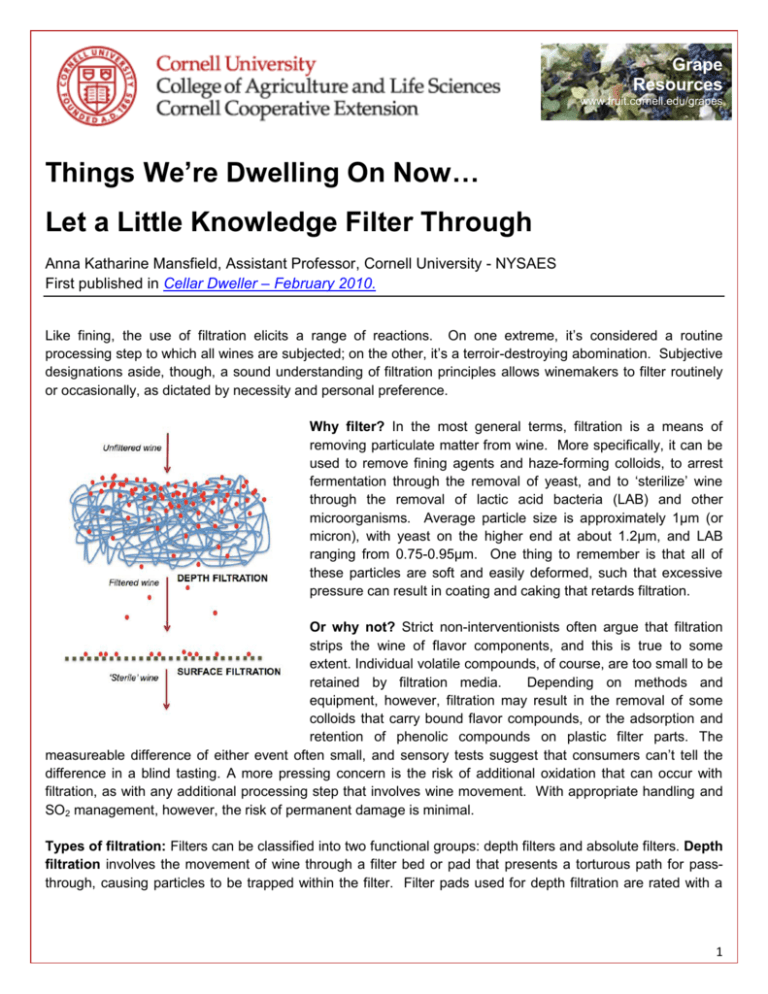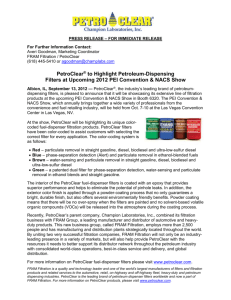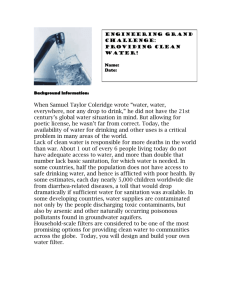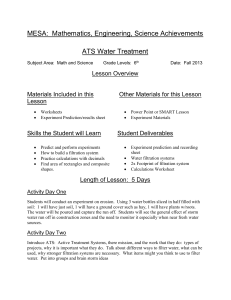Let a Little Knowledge Filter Through
advertisement

Grape Resources www.fruit.cornell.edu/grapes Things We’re Dwelling On Now… Let a Little Knowledge Filter Through Anna Katharine Mansfield, Assistant Professor, Cornell University - NYSAES First published in Cellar Dweller – February 2010. Like fining, the use of filtration elicits a range of reactions. On one extreme, it‟s considered a routine processing step to which all wines are subjected; on the other, it‟s a terroir-destroying abomination. Subjective designations aside, though, a sound understanding of filtration principles allows winemakers to filter routinely or occasionally, as dictated by necessity and personal preference. Why filter? In the most general terms, filtration is a means of removing particulate matter from wine. More specifically, it can be used to remove fining agents and haze-forming colloids, to arrest fermentation through the removal of yeast, and to „sterilize‟ wine through the removal of lactic acid bacteria (LAB) and other microorganisms. Average particle size is approximately 1μm (or micron), with yeast on the higher end at about 1.2μm, and LAB ranging from 0.75-0.95μm. One thing to remember is that all of these particles are soft and easily deformed, such that excessive pressure can result in coating and caking that retards filtration. Or why not? Strict non-interventionists often argue that filtration strips the wine of flavor components, and this is true to some extent. Individual volatile compounds, of course, are too small to be retained by filtration media. Depending on methods and equipment, however, filtration may result in the removal of some colloids that carry bound flavor compounds, or the adsorption and retention of phenolic compounds on plastic filter parts. The measureable difference of either event often small, and sensory tests suggest that consumers can‟t tell the difference in a blind tasting. A more pressing concern is the risk of additional oxidation that can occur with filtration, as with any additional processing step that involves wine movement. With appropriate handling and SO2 management, however, the risk of permanent damage is minimal. Types of filtration: Filters can be classified into two functional groups: depth filters and absolute filters. Depth filtration involves the movement of wine through a filter bed or pad that presents a torturous path for passthrough, causing particles to be trapped within the filter. Filter pads used for depth filtration are rated with a 1 nominal or normal porosity size; this rating indicates that some percentage (usually 99%) of particles of the stated size will be retained by the filter. The nominal rating is usually larger than the actual size of the filter pores, as smaller particles can be absorbed onto the filter medium. It‟s important to remember that nominal ratings are only valid under specified flow rates, and that any changes from the manufacturer‟s operating instructions will change the percentage of particles retained. Currently, the most common types of depth filtration are diatomaceous earth filters, sheet filters (plate and frame), and disc filters, though the first is becoming less common as health concerns about DE exposure increase. Absolute filtration: Also called membrane filtration, absolute filters present a sieve-like surface with specified, standard-sized pores. Subsequently, they are capable of trapping all particles larger than the pore size, but also clog easily and generally require prior depth filtration. Absolute filtration is often the final step prior to bottling, and is frequently used in so-called „sterile‟ filtration. Pore ratings for absolute filters are just that, and indicate the largest spherical particle that can pass through the filter pores. A pore size of 0.6μm is most commonly used to ensure yeast removal; a pore size of 0.45μm is used for bacteria. Crossflow or tangential filtration is a form of absolute filtration, but requires fairly large wine volumes to be economically feasible. What’s sterile filtration? “Sterile” filtration is generally performed just prior to bottling, and optimally is a sequential process of depth and absolute filtration. Depth filtration essentially removes all microorganisms, assuming proper operating procedures are observed. A final absolute filtration at 0.45μm ensures that any remaining microbes are retained, and also allows assurance testing of the system. The drawback of depth filtration is that filter integrity is impossible to test, while membrane filters can be assessed before and after filtration as proof that all microorganisms larger than 0.45μm were retained. Ultimately, decisions regarding the timing and frequency of filtration are dictated by stylistic goals and quality considerations, and specific filtration regimens must be tailored to fit each wine lot. Understanding how the process works, however, allows the winemaker to make educated choices for optimized wine quality. The information, including any advice or recommendations, contained herein is based upon the research and experience of Cornell Cooperative Extension personnel. While this information constitutes the best judgment/opinion of such personnel at the time issued, neither Cornell Cooperative Extension nor any representative thereof makes any representation, endorsement or warrantee, express or implied, of any particular result or application of such information, or regarding any product. Users of any product are encouraged to read and follow product-labeling instructions and check with the manufacturer or supplier for updated information. Cornell University provides equal program and employment opportunities. 2





